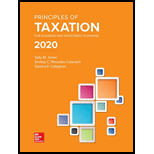
Principles Of Taxation For Business And Investment Planning 2020 Edition
23rd Edition
ISBN: 9781259969546
Author: Sally Jones, Shelley C. Rhoades-Catanach, Sandra R Callaghan
Publisher: McGraw-Hill Education
expand_more
expand_more
format_list_bulleted
Concept explainers
Question
Chapter 3, Problem 1AP
a.
To determine
Calculate
b.
To determine
Calculate net present value (NPV).
c.
To determine
Calculate net present value (NPV).
d.
To determine
Calculate net present value (NPV).
Expert Solution & Answer
Want to see the full answer?
Check out a sample textbook solution
Students have asked these similar questions
Saved
Required information
[The following information applies to the questions displayed below.]
On December 1, Jasmin Ernst organized Ernst Consulting. On December 3, the owner contributed $84,310 in assets to
launch the business. On December 31, the company's records show the following items and amounts.
$ 10,200 Cash withdrawals by owner
Cash
Accounts receivable
15,200
Consulting revenue
Office supplies
3,550
Rent expense
Land
45,990
Office equipment
18,310
Accounts payable
8,740
Salaries expense
Telephone expense
Miscellaneous expenses
Owner investments
84,310
$ 2,340
15,200
3,910
7,350
790
610
Use the above information to prepare a December 31 balance sheet for Ernst Consulting.
AC
Graw
Hill
ERNST CONSULTING
Balance Sheet
December 31
$
0
G-SYNC
$
0
S
0
B
Audit, Fraud, Or Forensic Accounting
Introduce yourself to your peers by sharing something unique about your background. Explain how you expect this course will help you move forward in your current or future career.
This course covers forensic accounting, so it's important to establish the differences between an audit, a fraud examination, and a forensic accounting engagement. Think about the fraud conviction of Elizabeth Holmes, as described in the video, "Elizabeth Holmes Found Guilty in Theranos Fraud Trial."
Then respond to the following:
Imagine you are assigned to the Theranos case.
Write the first five questions you would ask if you were an auditor, the first five questions as a fraud examiner, and the first five as a forensic accountant.
After your questions, explain why the questions and approaches are different among the three roles.
Be sure to respond to at least one of your classmates' posts.
Financial Account subject
Chapter 3 Solutions
Principles Of Taxation For Business And Investment Planning 2020 Edition
Ch. 3 - Does the NPV of future cash flows increase or...Ch. 3 - Explain the relationship between the degree of...Ch. 3 - Does the after-tax cost of a deductible expense...Ch. 3 - Prob. 4QPDCh. 3 - Prob. 5QPDCh. 3 - Prob. 6QPDCh. 3 - Prob. 7QPDCh. 3 - Which type of tax law provision should be more...Ch. 3 - In the U.S. system of criminal justice, a person...Ch. 3 - Identify two reasons why a firms actual marginal...
Ch. 3 - Prob. 11QPDCh. 3 - Prob. 12QPDCh. 3 - Prob. 1APCh. 3 - Prob. 2APCh. 3 - Prob. 3APCh. 3 - Use a 5 percent discount rate to compute the NPV...Ch. 3 - Consider the following opportunities: Opportunity...Ch. 3 - Prob. 6APCh. 3 - Refer to the income tax rate structure in the...Ch. 3 - Prob. 8APCh. 3 - Company N will receive 100,000 of taxable revenue...Ch. 3 - Prob. 10APCh. 3 - Investor B has 100,000 in an investment paying 9...Ch. 3 - Firm E must choose between two alternative...Ch. 3 - Company J must choose between two alternate...Ch. 3 - Firm Q is about to engage in a transaction with...Ch. 3 - Corporation ABC invested in a project that will...Ch. 3 - Prob. 16APCh. 3 - Investor W has the opportunity to invest 500,000...Ch. 3 - Prob. 18APCh. 3 - Prob. 19APCh. 3 - Prob. 20APCh. 3 - Prob. 21APCh. 3 - Prob. 1IRPCh. 3 - Firm V must choose between two alternative...Ch. 3 - Prob. 3IRPCh. 3 - Refer to the facts in problem 3. Company WB is...Ch. 3 - Prob. 5IRPCh. 3 - Prob. 6IRPCh. 3 - Prob. 7IRPCh. 3 - Prob. 8IRPCh. 3 - Prob. 9IRPCh. 3 - Prob. 1TPCCh. 3 - Firm D is considering investing 400,000 cash in a...
Knowledge Booster
Learn more about
Need a deep-dive on the concept behind this application? Look no further. Learn more about this topic, accounting and related others by exploring similar questions and additional content below.Similar questions
- General Accountarrow_forwardProvide answer general Accounting questionarrow_forwardDegregorio Corporation makes a product that uses a material with the following direct material standards: Standard quantity 2.7 kilos per unit Standard price $9 per kilo The company produced 5,700 units in November using 15,760 kilos of the material. During the month, the company purchased 17,830 kilos of direct material at a total cost of $156,904. The direct materials purchases variance is computed when the materials are purchased. The materials quantity variance for November is: a. $3,330 F b. $3,236 F c. $3,330 U d. $3,236 Uarrow_forward
- Subject: Financial Accountingarrow_forwardThe blending department had the following data for the month of March: Units in BWIP Units completed 7,200 Units in EWIP (40% complete) 750 $27,000 Total manufacturing costs Required: 1. What is the output in equivalent units for March? 2. What is the unit manufacturing cost for March?arrow_forwardGiven answer accounting questionarrow_forward
arrow_back_ios
SEE MORE QUESTIONS
arrow_forward_ios
Recommended textbooks for you
